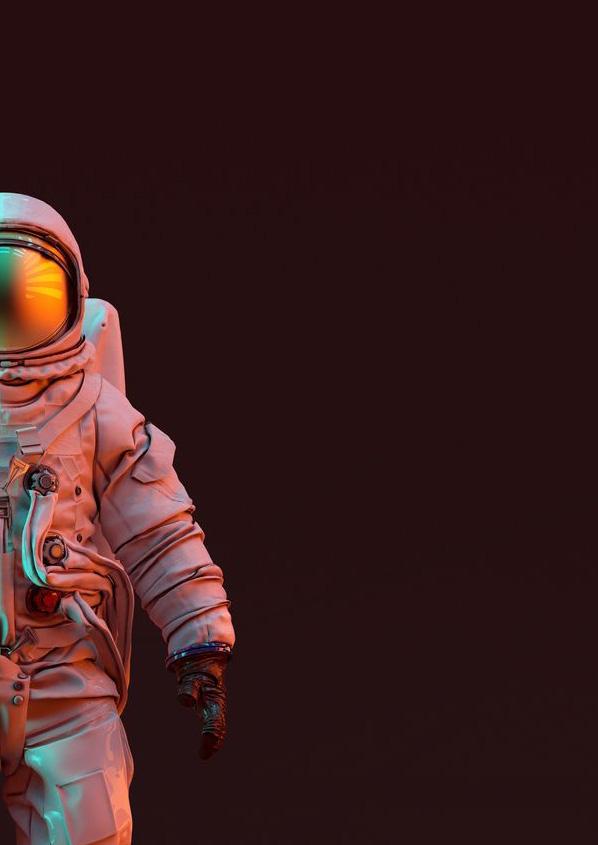
8 minute read
Was God an Astronaut?
By Holly Lovett
“It took courage to write this book, and it will take courage to read it”.
Advertisement
This is the opening of Erich Von Daniken’s Chariots of the Gods? first published in 1969 which explores an array of thought-provoking concepts involving extra-terrestrial life. On the whole, the text provides an intense journey of theories, strongly brought to life by Daniken, that suggest it is important to question everything. One of the main concepts that is woven through this piece is the idea that aliens from another planet may have visited Earth in the past, and the humans present, resulted in labelling them as ‘Gods’. The retelling of these visits were then passed down through the centuries to such an extent that they became branded as myths, stories and legends. Whilst reading it is important to keep in mind the year of publication, 1969, as it was in this same year that humans succeeded in their mission to the moon. In society, there was a shift in peoples opinions relating to religion and science, many people either loved the developments in the world or despised them all together. There was lots of tension in society at this time, particularly with the US Civil Rights movement and the assassination of President John F. Kennedy. It was debated that the ‘Space Race’ was wasting natural resources. But nevertheless, approximately 600million people watched the Apollo 11 moon landing on television and forgot their differences for a moment, joining together to experience this huge symbol of human achievement. It could be derived from Daniken’s theories that the
moon landing plays a big part in his own personal beliefs, and when reading this book, it is clear that the event created a hinge in civilisation that allowed people to think bigger than ever before. This concept is illustrated perfectly by Daniken’s comment that “even imagination needs something to start it off”. We are given an insight into many interesting points with the most striking one for me personally being “if our way of thinking worked the other way round, it would mean that intelligences on another planet took their living conditions as a criterion”. Daniken then segues into a wider debate as to whether planet earth has already been visited by extra-terrestrials through a description of different architecture, cave paintings and historical buildings.
The author appears to be in awe of technological advances. He claims that “nothing is incredible any longer. The word ‘impossible’ should have become literally impossible for the modern scientist” and with this determined attitude he moves onto a series of ideas as to why we should consider human potential to explore space further. He discusses his theory that “astronauts from distant planets visited the earth thousands of years ago” and poses the concept that “since the question of space travel did not arise a hundred years ago, our fathers and grandfathers could not reasonably have had thoughts about whether our ancestors had visits from the universe”. There may be many different interpretations of what the moon landing means for different people. Daniken believes that now nothing is preposterous, and many people viewed this movement into the ‘space age’ as being exciting, however there are people who argue that it is pointless to study extraterrestrial possibilities and human efforts should be focused on our own planet. To this, Daniken questions “can we still afford to close our eyes and stop up our ears because new ideas are supposed to be heretical and absurd? After all, the idea of a landing on the moon was absurd fifty years ago”. He follows on from this by stating that “as soon as we look into the past with our present-day gaze and use the fantasy of our technical age to fill the gaps in it, the veils that shroud the darkness begin to lift” and it can be inferred that he is suggesting the advances in technology, although being used to discover space, may also aid us with a wider knowledge of the origins and occurrences happening here on Earth.

As an author, Daniken is unapologetic, making bold statements and introducing complex proposals.
Petroglyphs from Val Camonica, Italy. Ancient astronaut proponents believe these pictures resemble modern astronauts.

Occasionally he pushes the boundaries of the readers dependence, it becomes easy to challenge his judgement. It is in the seventh chapter where Daniken delves into ancient Egypt more deeply, he attempts to present the reader with a viewpoint that many ancient activities were influenced by the society’s knowledge of space. Beginning with a discussion on the development of the Pyramids in Egypt, Daniken also comments on the theories of Egyptian gods. He claims that “it is well-known that ancient Egyptians practiced a solar religion” and by having a distinguished belief such as this unites a community and is a reason behind beliefs and tradition being passed down through generations. It is commented on by the author that “Mummies… stare at us from the remote past as if they held some magical secret” and this way of interpreting such a unique and aged practice is thought-provoking for readers. A possible view is constructed of a Pharaoh which describes that “the gods promised to return and wake me up (or doctors in the distant future will discover a way to restore me to life again)”. And, after considering the study carried out and published in 1965 by physician and astronomer Robert. C. W., Daniken writes on the scientific research from the biologists of the University of Oklahoma. It was confirmed that the skin cells of the Egyptian Princess Mene were capable of living “and Princess Mene has been dead for several thousand years”. This fascinating take on a possibility that humans may be able to be brought back to life is stimulating, and the author moves onto a series of reasoning as to why this idea is somewhat believable. He explains how “finds in Egyptian tombs provide example after example of the preparation of embalmed corpses for corporeal return” and that “drawings and sagas actually indicated that the ‘gods’ promised to return from the stars in order to awaken wellpreserved bodies to a new life”. This powerfully composed theory links together the idea that Gods may be highly intelligent astronauts from other planets. It is interesting in its proposition however

the way that the opinions are clustered together makes it appear as though it is simply a collection of thoughts, rather than a convincing hypothesis. This may be what Daniken set out to achieve as he comments regularly that it is important to question everything. It is important to note here that we are given an interesting insight into a particular era of conspiracist white society, Daniken's ideas may be controversial as he appears convinced that indigenous people were incapable of such knowledge and achievement. From this he suggests that praise should be directed at extra terrestrial beings. The
quote “but the questions are there, and questions, thank heavens, have the impertinent quality of hovering in the air until they are answered” encapsulates this perfectly.
In order for the Apollo 11 mission to succeed there was a host of technological advances required involving innovations in space-age materials such as computers and rockets. The 1960s brought a new era of technology with its historic developments. Daniken debates that “today, in the twentieth century, no architect could build a copy of the Pyramid of Cheops, even if the technical
resources of every continent were at his disposal”. This forces a question as to whether Daniken is really trustworthy as a writer. He is confident that humans cannot recreate such complex building but is he looking at all of the reasons as to why humans would not want to build such vast structures that may be seen as largely impractical for the modern-day world? Daniken frequently attempts to acknowledge why his points may be controversial but is quick to cover himself up with reasoning and interpretation. His opinion on research is outlined through the remark that “without this study of the future, we should probably have no chance of unravelling our past”.

Daniken consults with the legend that surrounds Easter Island, a location famous for its huge monoliths carved into the shape of human heads. After a discussion over the theories as to how the material for these structures may have been transported across the land and into position, Daniken confers that the islands natives title their home as “land of the bird men”. It is claimed that “an orally transmitted legend tells us that flying men landed and lit fires in ancient times” but this is a questionable idea as even though the author attempts to make some truth of the legend, his confident affirmation that “the legend is confirmed by sculptures of flying creatures with big staring eyes” we become suspicious of his reliability. Many would argue that this assumption has little grounds to make it seem trustworthy and this puts the author in a compromising position as we begin to doubt whether his cluster of unique theories are legitimate and worth pondering over. On the whole, this controversial text has some incredibly enthralling topics that can set the brain on a spiral of possible theories. Yet it is Daniken’s casual tone and sweeping statements that make us view his debates as occasionally problematic. As Daniken suggests himself, “the forest of question marks grows”.
Details of the carved lid of the tomb of K’inich Janaab Pakal I in the Temple of the Inscriptions











